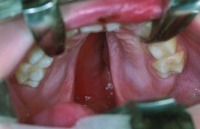
The new type of hydrogel material was recently evaluated at the Science and Technology Facilities Council’s ISIS neutron source facility following research and development at Oxford University’s Department of Materials, John Radcliffe Hospital and the Georgia Institute of Technology in the US.
It is envisioned that this gel could help reconstruct facial lip and palate defects by surgically inserting it under the mucosa that lines the roof of the mouth. Once inserted, the hydrogel would gradually expand as it absorbs fluid and encourage skin growth over and around the plate. After sufficient skin has been generated to repair the palatal cleft, the plate would be removed.
The procedure, which is being readied for clinical trials in 2011, is expected to have a major impact.
The Cleft Lip and Palate Association estimates that one in nearly 700 babies in the UK are born with this condition. A cleft is a split that can occur during early pregnancy. During this period of gestation separate areas of the face develop individually. If these parts do not join properly, it will create a cleft that can vary in type and severity.
Babies born with cleft palates can be prone to a number of disorders that can initially include problems feeding and, later in life, speech and hearing difficulties, teeth and facial growth problems.
If the new hydrogel reconstructive procedures are proven successful, it will be the result of years of research and development involving expertise in the fields of both materials engineering and medical science.
Former Oxford materials researcher David Bucknall, now at the Georgia Institute of Technology in the US, said the use of hydrogel had been developed for other medical procedures in the past. Most notably, he explained, the material was used by German researchers who looked at the use of hydrogel expanders for defects associated with children born without eye sockets.
Bucknall said what makes his group’s use of hydrogels different is their material has anisotropic properties, so it expands more in one direction than another.
The team was able to achieve this property, he said, by starting with a contact lens-like material and slightly altering the concentrations of polymers in it.
Bucknall explained contact lenses require two types of polymers: one that is hydrophilic, meaning it attracts water and the other a more rigid methacrylate polymer, otherwise known as Perspex.
He said: ’For a soft contact lens, you choose one of the polymers to be the water absorber and that’s what makes it soft rather than hard. But then you need mechanical rigidity so it is possible to pull it in and out of your eye and it doesn’t fall apart and has lens properties.’
The Oxford and Georgia team altered the properties of the solution by increasing the concentration of the hydrophilic components and strategically mixing it in the material in a way that encourages anisotropic expansion.
These properties were studied on the molecular level at the ISIS neutron source facility. Bucknall said his team was trying to understand what the water does before going into the pre-expanded gel.
He added: ’We wanted to see how it affects the polymer structure and we can track that using neutron scattering because we can use contrast between water and the polymer itself to follow the progress of the water in the system.’
Bucknall said there is an urgent desire from the medical community to deploy hydrogel for surgical use. He added that it could be applied for uses beyond cleft lip and palate reconstructive procedures. Other potential medical applications, according to Bucknall, could include difficult dental surgeries and operations on patients with traumatic burns.










National Gas receives funding to develop Gravitricity underground hydrogen storage system
One single rock salt mine - Winsford - has 23 <i>MILLION </i>cubic metres of void and even allowing for 10% of that void set aside for hazardous waste...